The Composition of Pha Luang Melody
Main Article Content
Abstract
This research is a qualitative research. The objectives are (1) to compose fabric Luang song lyrics and melodies, (2) to develop a body of knowledge in song creation. In this research, sample group is composed of Thai Music Specialist and Thai silk experts in fabric Luang (Northern Thailand). Interviews and questionnaires are employed in data collection. Investigation of the method of silk weave, pattern and interrelation between the method and pattern contributes to song composition with free composition technique which is applied for music innovation infiltrated by its local accent. It is found that fabric Luang song whose accent is Northern, whose melody proceeds with overlapping and dipping technique for musical performance to reflect silk line dip in weaving process which creates water flow design.
This research is a combination of Thai musical performance and Thai manufacture, which is composed of melody translation, melody coordination with sound relation principle, innovated pattern musical instrument coordination for melody procession, and unity of song created by harmony between the rhythm and melody patterns and the silk weave techniques and musical instruments used to convey their local identities.
Article Details
Proposed Creative Commons Copyright Notices
1. Proposed Policy for Journals That Offer Open Access
Authors who publish with this journal agree to the following terms:
- Authors retain copyright and grant the journal right of first publication with the work simultaneously licensed under a Creative Commons Attribution License that allows others to share the work with an acknowledgement of the work's authorship and initial publication in this journal.
- Authors are able to enter into separate, additional contractual arrangements for the non-exclusive distribution of the journal's published version of the work (e.g., post it to an institutional repository or publish it in a book), with an acknowledgement of its initial publication in this journal.
- Authors are permitted and encouraged to post their work online (e.g., in institutional repositories or on their website) prior to and during the submission process, as it can lead to productive exchanges, as well as earlier and greater citation of published work (See The Effect of Open Access).
Proposed Policy for Journals That Offer Delayed Open Access
Authors who publish with this journal agree to the following terms:
- Authors retain copyright and grant the journal right of first publication, with the work [SPECIFY PERIOD OF TIME] after publication simultaneously licensed under a Creative Commons Attribution License that allows others to share the work with an acknowledgement of the work's authorship and initial publication in this journal.
- Authors are able to enter into separate, additional contractual arrangements for the non-exclusive distribution of the journal's published version of the work (e.g., post it to an institutional repository or publish it in a book), with an acknowledgement of its initial publication in this journal.
- Authors are permitted and encouraged to post their work online (e.g., in institutional repositories or on their website) prior to and during the submission process, as it can lead to productive exchanges, as well as earlier and greater citation of published work (See The Effect of Open Access).
References
[2] Dittapan, Suppakorn. (2003). Creativity and Creativity Development. Bangkok: Chulalongkorn University Printing House.
[3] Fakjamroon, Sirichaichan. (2003). Thai Arts of Musical Performance. Bangkok: Institute of Thai Studies Printing House, Chulalongkorn University.
[4] Jaturapat, Laksanawadee. (2001). Series of Archeological Dance Songs: A Creative Work of Montree Pramote. Master of Arts Thesis, Cultural Studies. Mahidol University.
[5] Kanjaikaew, Sai. (2016, September 4). Interview. Luang Fabric Weaving Expert.
[6] Kerdpon, Samran. (2016, October 19). Interview. National Artist in Performances (Thai Music) of 2005.
[7] Lisuwan, Wiboon. (2007). An Encyclopedia of Fabrics and Woven Goods. Bangkok: Muang Boran Publishing House.
[8] Local Weaving Development Project in Every Province of Thailand, Silpakorn University. (2000). Local Northern Weaving. Bangkok: Amarin Printing & Publishing.
[9] Luang Fabric Patterns. (n.d.) Retrieved January 9, 2017, from https://www.creativetourism.comc.jpg
[10] Na-Nan, Pensri. (2016, September 5). Interview. Luang Fabric Weaving Expert.
[11] Noinit, Tirapon. (2016, October 15). Interview. Qualified Thai Music Expert.
[12] Panyayot, Rakkiat. (2016, October 2). Interview. Qualified Expert on Northern Folk Music.
[13] Pitakrat, Narongchai. (2009). Knowledge from A National Artist: Mr.Pinit Chaisuwan. Office of the National Culture Commission, Ministry of Culture, Fiscal Year 2009. (Copied)
[14] Promrianchai, Tanee. (2016, September 5). Interview. Luang Fabric Weaving Expert.
[15] Pukaotong, Sangad. (1996). Thai Music and the Entrance to Thai Music. 2nd ed. Bangkok: Ruankaew Publishing House.
[16] Rodchangpuan, Pakorn. (2016, October 8). Interview. Distinguished Professor.
[17] Samrongtong, Bootsakorn. (2003). Lyrics to Thai-Norwegian Friendship Songs. Invention Project, Ratchadaphiseksomphot Endowment Fund, Chulalongkorn University.
[18] Tramote, Boontam. (2002). Description of Thai Music Subjects. Bangkok: Chuanpim Printing House.
[19] Tramote, Montree. (1995). Mr.Montree Tramote’s Musical Message. Remembrance of the State Funeral of Mr.Montree Tramote. (pp.39-43). n.p.
[20] Wongtet, Sujit. (1999). Prachumbot Mahori. Bangkok: Ruankaew Printing House. (in Thai)


